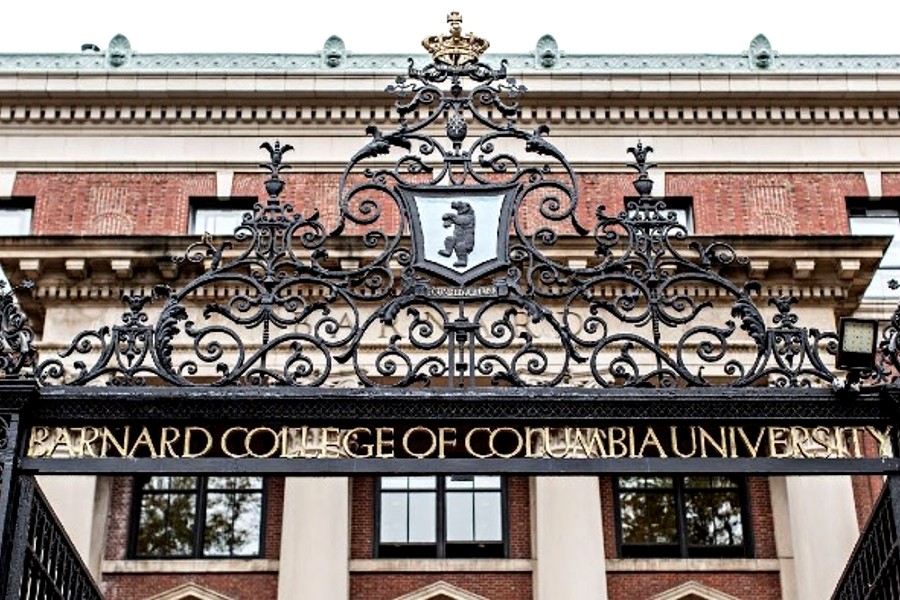 New York Juvenile Asylum, 175th Street near between 10th and 11th Avenues just north of Harlem in Washington Heights, New York, 1872.
New York Juvenile Asylum, 175th Street near between 10th and 11th Avenues just north of Harlem in Washington Heights, New York, 1872.
Dayton in Manhattan writes that an impressive Gothic-inspired building was opened on April 2, 1856 to replace the original structure which Asylum directors called “dreary, comfortless, inconvenient and insecure as can well be imagined.” It offered open space and fresh air to the urban children. The youths who were removed from the streets did not come here directly.
“Within these ten days, the parents or guardians, if to be found, are to be notified of the arrest of the child, and that they may appear and show cause for his discharge. Failing to do this, the law deprives them of all custody of the child, and transfers their rights to this Corporation, who thenceforth stand to him in loco parentis,” as recorded in the Charter.
 The children who arrived at the House of Reception were immediately taken to the bathing room where all their clothes were removed and if “as frequently found to be the case, they are either worthless as garments, or are infested with vermin, they are burned or otherwise disposed of.” The children were then bathed, inspected by a doctor, given a new suit of clothes “suited to the season of the year,” and given a meal.
The children who arrived at the House of Reception were immediately taken to the bathing room where all their clothes were removed and if “as frequently found to be the case, they are either worthless as garments, or are infested with vermin, they are burned or otherwise disposed of.” The children were then bathed, inspected by a doctor, given a new suit of clothes “suited to the season of the year,” and given a meal.
Not all the inmates arrived here as a result of arrest. Their parents often brought them to the House of Reception simply out of the frustration of not being able to control their children. From the moment they entered the House of Reception, they knew they had lost control of their young lives.
“The hours for rising, for daily ablutions, for worship, for meals, for school, for play, and on the Sabbath for Sunday school and religious services, are all fixed. The children are thus at once taught to do right things and at the right time,” the Annual Report noted
But turning street toughs into respectable citizens was not an easy matter. The boys had learned to survive through brute force and guile and those instincts hung on. Late at night on October 2, 1860, for instance, Officer Leary heard “the cry of murder” coming from the House of Reception. When he arrived in one of the upstairs rooms, he found Robert Winn bleeding from wounds in his side and forehead. Winn identified his roommate, William Rigby, as having stabbed him.
Childrens Village writes that in 1851, a group of philanthropists concerned about the growing problem of homeless immigrant children living on the streets of Manhattan founded The New York Juvenile Asylum.
This institution cared for more than 1,000 boys and girls, providing housing, education and work skills. Admission statistics over the years mirror the waves of immigration to the United States.
By the turn of the century, the organization’s property in Washington Heights, which had been purchased for $33,000 in 1854, had risen in value to more than a million dollars.
The 1856 Report said “The plan of the Juvenile Asylum does not contemplate the retention and maintenance of the children committed to its care for a period longer than may be necessary to implant new and correct views of life, its objects and its end, in their minds; relieve them of present physical evils, and instruct them how to avoid relapsing into them; to give them the rudiments of a common school education, and to teach them the practicability and importance of self-discipline of body, or mind, and of heart.”
And to accomplish this the children, mainly the boys, were indentured. “But when the seed is sown, we relinquish the cultivation to others,” said the Report. Therefore children were supplied to families, often in the West, who needed extra manpower in running a farm or other business.

“Several companies of children are sent annually to the Western States, to be indentured to farmers and others, under the direction of a judicious person. Children are also bound out in the city and vicinity as occasion offers,” reported the Gazetteer of the State of New York in 1860.
The New York Times added on November 1, 1861 “These children are gathered from the streets for vagrancy, begging, petty thefts, etc., brought under careful training and instruction, and as rapidly as their characters will warrant are sent out to Western homes. Forty-three boys and girls, who had received from one to three years’ care, were sent out on Monday to Western homes under charge of Mr. Allen, the Indenturing Agent.”
The arrangement did not always work out. The 1856 Report noted that some children were returned. Of the 324 children indentured during 1855, 20 came back. “Of these, one plead home-sickness; another, over work; a third, that he had but two meals a day others, ill usage which was apparent enough in the rags with which some of them were clad…Of the few returned by their masters, the reasons assigned were ill-health, or physical inability to work.”
In these years before the Civil War, the indenturing of children smacked of slavery. The New York Journal of Commerce in 1858 reported that “a selection of boys and girls, chosen from a larger lot of 400,” were to be “examined and sold at the House of Reception, No. 23 West 13th Street.” The article promised a bill of sale after cash was paid.
The Juvenile Asylum defended its policy of separating children from their parents. “Mere animal attachment, which man has for his offspring, in common with wild beasts, sometimes pleads with us vociferously but unless this is accompanied by an evident feeling of moral responsibility, we are compelled to govern our decisions by a regard for the higher interests of the child and the welfare of the community, of which he is to be an integral part, and in which he is to exercise an influence for weal or for woe, on others.”
Life for children at the Asylum was not one of comfort and ease. The directors stressed that their “physical natures” must be regulated “according to inflexible laws, not neglected under the promptings of sloth, nor pampered and indulged under the cravings of appetite and lust.” While the directors insisted they wanted to be “friends” with the inmates, “we do not believe in the mawkish, sentimental and infidel philosophy of modern days, which discards, as the mere gropings of the mind in by-gone ages of darkness, the Bible method of disciplining the child into obedience. When a child deserves punishment, and will not be won by patient kindness, he is punished.”
The Report added, however, that “the spirit with which that punishment is administered is love, and the motive, his amendment.”
In these years before the Civil War, the indenturing of children smacked of slavery. The New York Journal of Commerce in 1858 reported that “a selection of boys and girls, chosen from a larger lot of 400,” were to be “examined and sold at the House of Reception, No. 23 West 13th Street.” The article promised a bill of sale after cash was paid.
The Juvenile Asylum defended its policy of separating children from their parents. “Mere animal attachment, which man has for his offspring, in common with wild beasts, sometimes pleads with us vociferously but unless this is accompanied by an evident feeling of moral responsibility, we are compelled to govern our decisions by a regard for the higher interests of the child and the welfare of the community, of which he is to be an integral part, and in which he is to exercise an influence for weal or for woe, on others.”

Life for children at the Asylum was not one of comfort and ease. The directors stressed that their “physical natures” must be regulated “according to inflexible laws, not neglected under the promptings of sloth, nor pampered and indulged under the cravings of appetite and lust.” While the directors insisted they wanted to be “friends” with the inmates, “we do not believe in the mawkish, sentimental and infidel philosophy of modern days, which discards, as the mere gropings of the mind in by-gone ages of darkness, the Bible method of disciplining the child into obedience. When a child deserves punishment, and will not be won by patient kindness, he is punished.”
The Report added, however, that “the spirit with which that punishment is administered is love, and the motive, his amendment.”
The in-house schooling was divided into two sections, alternating between academic studies and the “workshop.” Worship services were conducted twice a day, morning and evening. Boys who learned to make shoes worked four hours every day, five days a week. The shoes were sold at a profit of $6 per case, earning the Asylum between $4 and $6 a day “whilst the children enjoy the instruction and supervision of a competent and trustworthy overseer.”
Not surprisingly, children routinely attempted escape. Thirty-nine inmates fled in 1855. The directors did not view the rigid and harsh environment as motive. Instead they explained “the children, before their surrender to us, have generally been as unfettered in their movements as the wild Arab…Can it be surprising that children, with such habits, should be restive under the restraints and forms of a disciplinary institution?”
Recaptured escapees were justly disciplined. “It is encouraging to know that the large majority soon discern their past errors, and quietly submit to the discipline to which they are necessarily subjected. Many, again, of the runaways, on their re-arrest, succumb, and conduct themselves with propriety.”
The girls of the Asylum received training in sewing and letters. The directors were aghast at the depth of the girls’ ignorance upon being admitted. “Aside from their want of all moral training, they are strikingly heedless; and unable to sew or perform any other description of work.”
The Juvenile Asylum was determined to make these girls model citizens and wives. “They are drilled into thoroughness in all that they undertake; and, instead of growing up to be drones and beggars, fitted for a career of degrading vice and for an early grave, they now bid fair to be industrious, useful, and virtuous members of society.” The girls were taught to “read, right and cipher,” as well as to sew. The girls’ needlework was exhibited and sold at a fair in the Fall.
Health was a problem in the crowded asylum. The Annual Report of 1856 noted that “quite a number…suffered from chilblains,” which required hospitalization. Thirty-five children contracted epidemic ophthalmia that year. Worse, nine children died. Two died from dysentery; one boy, an epileptic “was suddenly seized with diarrhea and soon sank from exhaustion;” one died from typhus fever; one drowned; and “one of hypertrophy of the heart; one of hemorrhage from sloughing of the cheek; one of congestion of the brain.”

A writer for The New York Times visited the Asylum in 1862 and praised the building and the organization. If there were health problems at the time, he did not notice. “Quantities of fresh sweet milk are brought daily from a neighboring dairy, and, though bread and milk is the standard dish for breakfast and supper, the noon-day meal is distinguished by a wholesome and palatable variety of meat and vegetables. Little use is made of the hospital, and the inmates are as a general thing contented with their lot.”
Before long a new facility had been built and the brooding Gothic asylum structure was razed in 1901. Its demolition ended a dark, Dickensonian period of which most New Yorkers are totally unaware.
The Board of Directors made the decision to sell this property and purchase a 277-acre farm in Dobbs Ferry, NY to build one of the first therapeutic communities in the United States. The new site was designed to create a home-like environment with cottages grouped in neighborhoods and a central quad for academics, work and recreation. The design won a gold medal for architecture at the 1906 World’s Fair in St. Louis.
The move to Dobbs Ferry heralded new ideas about the care and treatment of children. The number of children was reduced to 300 and the method of care was modeled on family life, with married couples and matrons living with the children. To reflect this new era, the name was changed to The Children’s Village.
Photo credit: 1). An 1856 print in the Asylum’s Annual Report depicts gleeful and well-dressed children rolling hoops, playing tag and ring-around-the-rosy. In truth things were a bit harsher. (copyright expired). 2) A lithograph by Lithograph of Charles Hart taken from a photograph by R. Horton, 2287 3rd Ave. Harlem, NY. 3) Young boys learn to make shoes in the late 19th century. Note the shadeless gas jet hanging over the table. photo Library of Congress. 4) Morning and evening meals consisted of bread, baked by inmates, and milk —photo Library of Congress
Become a Harlem Insider!
By submitting this form, you are consenting to receive marketing emails from: Harlem World Magazine, 2521 1/2 west 42nd street, Los Angeles, CA, 90008, https://www.harlemworldmagazine.com. You can revoke your consent to receive emails at any time by using the SafeUnsubscribe® link, found at the bottom of every email. Emails are serviced by Constant Contact

















